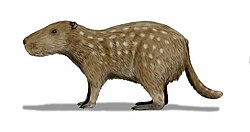| Birbalomys Temporal range: | |
|---|---|
| Scientific classification | |
| Kingdom: | Animalia |
| Phylum: | Chordata |
| Class: | Mammalia |
| Order: | Rodentia |
| Suborder: | Hystricomorpha |
| Superfamily: | Ctenodactyloidea |
| Family: | † Chapattimyidae |
| Genus: | † Birbalomys Sahni & Khare, 1973 |
| Species | |
Birbalomys is an extinct genus of rodent from Asia.
The 30 cm (12 in)-long creature has been thought to have been a member of the extant gundi family, but reconstructions of its physical appearance are speculative. Birbalomys bear resemblance with the Ctenodactyloidea, Chapattimyidae, and Yuomyidae families. [1]














